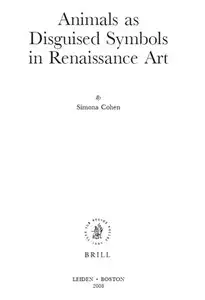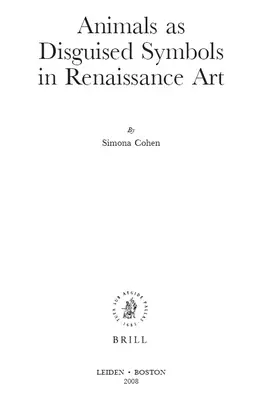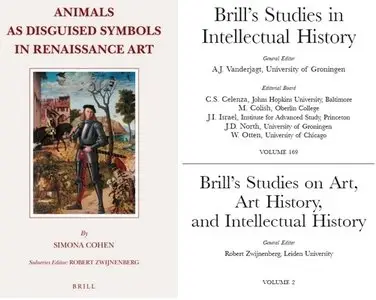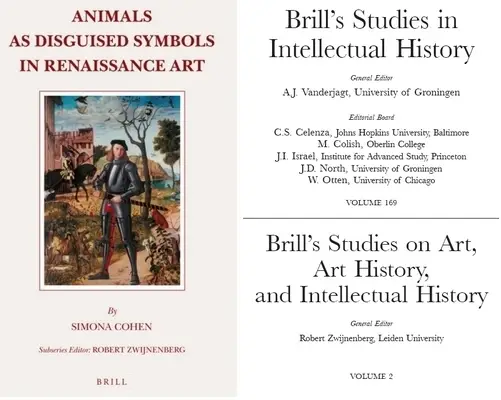"Animals as Disguised Symbols in Renaissance Art" by Simona Cohen
Brill's Studies in Intellectual History, vol.169. Brill’s Studies on Art, Art History, and Intellectual History, vol.2
Koninklijke Brill | 2008 | ISBN: 9047424328 9004171010 9789047424321 9789004171015| 360 pages | PDF | 9 MB
Brill's Studies in Intellectual History, vol.169. Brill’s Studies on Art, Art History, and Intellectual History, vol.2
Koninklijke Brill | 2008 | ISBN: 9047424328 9004171010 9789047424321 9789004171015| 360 pages | PDF | 9 MB
Filling a gap in the relationship between medieval animal symbolism and the iconography of animals in the Renaissance culture, in general, and its art, in particular, this book demonstrates the continuity and tenacity of medieval animal interpretations and symbolism, disguised under the veil of genre, religious or mythological narrative and scientific naturalism.
An extensive introduction, dealing with relevant medieval and early Renaissance sources, is followed by a series of case studies that illustrate ways in which Renaissance artists revived conventional animal imagery in unprecedented contexts, investing them with new meanings, on a social, political, ethical, religious or psychological level, often by applying exegetical methodology in creating multiple semantic and iconographic levels.
CONTENTS
List of Illustrations
Acknowledgements
Colour Plates
Introduction
PART ONE. THE HERITAGE AND SOURCES
Chapter One. Medieval Sources of Renaissance Animal Symbolism
Concealing the Tracks: The Physiologus and Bestiary Tradition
A Monkey on the Roof: Animal Moralizations in Exempla Literature and Sermons
Animal Moralizations in Medieval Encyclopedias
The Psychomachia Tradition and Images of Mounted Vices
Chapter Two. Renaissance Naturalists and Animal Symbolism: Fact and Fantasy
Bestiaries of the Fifteenth Century: The Monsters of Pier Candido Decembrio’s De animantium naturis
The Timid Hare and Lustful Camel: Leonardo da Vinci’s Bestiary
Natural History in the Sixteenth Century
Chapter Three. Emblematic Literature and Related Sources
Andrea Alciato’s Emblematum Libellus: Its Sources and Infl uence
The Symbola et emblemata by Joachim Camerarius
The Traditional and Retrospective Aspect of the Renaissance Emblem
PART TWO. CASE STUDIES
Chapter Four. The Birds and Animals of Carpaccio’s Miles Christianus
The miles christianus as Metaphor
Aspects of Carpaccio’s Visual Language
Animals and Birds
Flowers of Virtue
The Problem of the Portrait
Carpaccio’s Message
Chapter Five. The Enigma of Carpaccio’s Venetian Ladies
The Problem of Artistic Genre
The Precarious Legs of the Peacock
Cortegiane or Nobiltà?
The Heraldic Arms
Copies of Carpaccio’s Venetian Ladies
The History of the Kendall Copy
Iconographic Evidence (I): Carpaccio’s Panel
Animal Symbolism
Signifi ers and Contexts
Iconographic Evidence (II): The Copies
Reconstructing the Function of the Painting
Chapter Six. Animals in the Paintings of Titian: A Key to Hidden Meanings
The Dog as a Symbol of Sin
The Stag and the Hunt
Moralizations of Ovid
Animals and Ovidian Fables
The Late Mythologies
Veronese’s Commentary
Chapter Seven. Titian’s London Allegory and the Three Beasts of his Selva Oscura
An Allegory of Prudence?
Precedents in Renaissance Art
The Beasts of Dante’s Inferno
The Mirror of Human Morals
Elements of the Visual Tradition
Titian and Moral Allegory: The Problem Defi ned
Titian, Sensuality and Sin
Titian and the Catholic Reformation
The Theme of Penitence in Titian’s Late Works
Initium Poenitentiae Cognitio Peccati
Chapter Eight. Animal Heads and Hybrid Creatures: The Case of the San Lorenzo Lavabo and its Sources
Unresolved Issues
The Lavabo and Font
Animal Depictions and Metaphors of Sin
Interpreting the Animals
The Wolf
The Dog
The Lion
Other Animal Representations of Sin
Hybrid Creatures
Combined Animals/Sins: Renaissance Precedents
The Triad
Renaissance Animal-Heads
The Tuscan Tradition
The Iconography of the Lavabo
The San Lorenzo Lavabo and Medici Patronage
Chapter Nine. Andrea del Sarto’s Madonna of the Harpies and the Human-Animal Hybrid in the Renaissance
Documentation of the Painting
Identifying the ‘Harpies’
Human-Animal Hybrids
The Franciscans and Marian Iconography
Iconography for Nuns
Images of Eroticism and Fertility
Chapter Ten. The Ambivalent Scorpio in Bronzino’s London Allegory
The Terrestrial and Celestial Scorpions
The Medieval Scorpio
Scorpio in the Renaissance
Scorpio and Syphilis
Bronzino’s Satire
Epilogue
Select Bibliography
Index
with TOC BookMarkLinks





